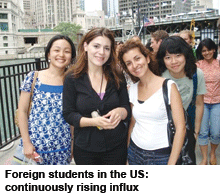United States: Most favoured academic mecca
The number of overseas students attending university in the US reached a record 764,495 during the academic year 2011-12, according to figures from the Institute of International Education.
The data, published annually in partnership with the US Department of State’s Bureau of Educational and Cultural Affairs, shows a 6 percent increase on the previous year and reveals that foreign students contributed $22.7 billion (Rs.123,546 crore) to the US economy during 2011-12.
 The number of international students in US higher education has risen for six consecutive years, and there are now 31 percent more of them studying in US colleges and universities than a decade ago. According to the data, the number of Chinese enrolments is up 23 percent in total, 31 percent — among undergraduates alone — the largest increase at that level. There was also a 50 percent rise in student enrolments from Saudi Arabia, explained by the greater availability of Saudi government scholarships. There was a 2.7 percent rise in the number of British students opting to study in the US, increasing from 8,947 to 9,186.
The number of international students in US higher education has risen for six consecutive years, and there are now 31 percent more of them studying in US colleges and universities than a decade ago. According to the data, the number of Chinese enrolments is up 23 percent in total, 31 percent — among undergraduates alone — the largest increase at that level. There was also a 50 percent rise in student enrolments from Saudi Arabia, explained by the greater availability of Saudi government scholarships. There was a 2.7 percent rise in the number of British students opting to study in the US, increasing from 8,947 to 9,186.
However, numbers from India, South Korea and Japan have declined (down 4 percent, 1 percent and 6 percent, respectively), a downturn driven by global economic factors, improved domestic higher education and stronger employment opportunities at home.
Meanwhile, the number of Americans opting to study abroad hit an all-time high in 2010-11, with 273,996 earning credit at foreign institutions — an increase of more than 1 percent on the previous year. The UK remained the leading destination (33,182 US students), followed by Italy (30,361), Spain (25,965) and France (17,019). Twelve percent more went to India to study, while the numbers heading to China rose by 5 percent.
Conversely, there was a 33 percent decline in the number opting for Japan, with the 2011 earthquake and tsunami putting Americans off. There was also a 42 percent decrease among students heading for Mexico after the State Department issued travel warnings.
Dark clouds over academia
On the face of it, American higher education is still in rude good health. In worldwide rankings more than of the top 100 universities, and eight of the top ten, are American. The scientific output of American institutions is unparalleled. They produce most of the world’s Nobel laureates and scientific papers. Moreover college graduates, on average, still earn far more and receive better benefits than those who don’t have a degree.
Nonetheless, there is growing anxiety in America about higher education. A degree has always been considered the key to a good job. But rising fees and increasing student debt, combined with shrinking financial and educational returns, are undermining the perception that university is a good investment.
Concern springs from a number of factors: steep rises in fees, increases in the levels of debt of both students and universities, and declining quality of graduates. Start with fees. The cost of university per student has risen by almost five times the rate of inflation since 1983, making it less affordable and increasing the amount of debt a student must take on. Between 2001-10, the cost of university education soared from 23 percent of median annual earnings to 38 percent. Consequently debt per student has doubled in the past 15 years with two-thirds of graduates now availing loans. Those who earned bachelor degrees in 2011 graduated with an average debt of $26,000 (Rs.14.30 lakh), according to Project on Student Debt, a non-profit group.
At the same time, universities have been spending beyond their means. Many have taken on too much debt and have seen a decline in the health of their balance-sheets. Moreover, securitisation of student loans led to a rush of unwise private lending. This, at least, has now been curbed by regulation. In 2008, private lenders disbursed $20 billion (Rs.110,000 crore); last year they shelled out only $6 billion (Rs.33,000 crore).
American universities cannot look to government to come to the rescue. States have already cut back dramatically on the amount of financial aid they give universities. President Obama has made it clear he is unhappy about rising tuition fees, and threatens universities with aid cuts if they rise any further. Roger Brinner from the Parthenon Group, a consultancy, predicts that enrolment rates will stay flat for the next five-seven years even as the economy picks up. The party may well and truly be over.
(Excerpted and adapted from Times Higher Education and The Economist)














Add comment